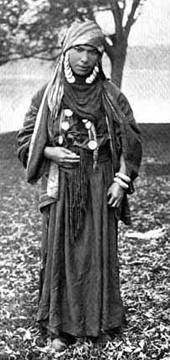
Syrian Bedouin girl at the 1893 Columbian Exposition
In his picturesque memoir of life in late 19th century Palestine, Philip J. Baldensperger recounts a number of adventures he had as a young man visiting his parent’s land with a Bedouin group. One of the foods loved by the Bedouin was the fruit of the doum palm. One day a group of Bedouin girls were surprised to see Philip’s white skin, something of a novelty at the time in rural Palestine. Here is his account:
“Being the only European, it was thought, in those days (1874), to be safer for me to wear Bedawi-clothing: a long shirt with broad, pointed sleeves hanging to the ground, a Sayé, and, on my head, a silken Kafiyé. With the exception of the girdle, which held the skirt and the Sayé together, the ‘Akal, or head-cird, wound around the Kafiyé, and a fringe of hair hanging over my forehead, in accordance with the fashion among Bedawîn youngsters, I was a figure in spotless white. In order to be able to walk more easily whilst on the march, I used to gather up the long folds of my dress and stick them in my girdle, leaving my legs bare. No wonder that one day four Bedawiyat, gathering Dôm-apples in the forest, fled with loud screams at my approach. They had never seen a white boy before and must have imagined that a Jân, or guardian of the forest, had appeared to drive them home. Fearing that their silly behavior might be wrongly interpreted in the camp, I shouted to them at the top of my voice to stop. They obeyed, a little through feminine curiosity, a little through fear; then, timidly, in response to my parlaying, they advanced, until at last they had drawn near enough to pinch my arms and legs and make certain that I was an authentic son of Adam. To account for my white skin and white Kafiyé, which is often dark with the Bedawîn, I explained to them that I was a Frank. Never before had they set eyes on a ‘Franji’ and once more, impelled by curiosity, they stretched out their tattooed arms to touch my body. To seal our friendship everyone offered me Dôm-apples until I had as many as I could carry, wrapped – Bedawi fashion – in the long sleeves of my ample gown. But I am inclined to think that, after all, they were not quite convinced. For they retreated cautiously, with many backward glances, and the youngest, a girl of fourteen, attempting to hide behind the others, until they finally disappeared behind the half-burned bushes.â€
Excerpt from Philip J. Baldensperger, The Immovable East, London, Sir Isaac Pitman and Sons, 1913, pp 36-38.